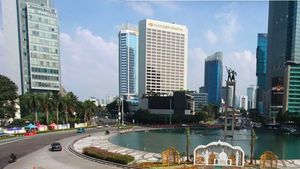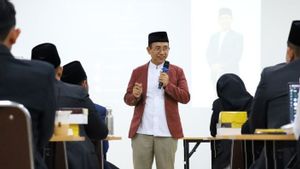JAKARTA - Robotic surgery development projects in Indonesia are still faced with challenges in the funding sector to public trust in accessing services.
"The legal umbrella for the development of robotic surgery is regulated in telemedicine provisions in Indonesia. If there is a failure due to equipment or information technology transmission interference, that has not been prepared," said Special Staff of the Minister of Health for the Resilience of the Pharmaceutical and Medical Devices Industry, Laksono Trisnantoro who was interviewed via Zoom in Jakarta, Antara, Thursday, June 30.
Robotic surgery is a method of surgery with the help of robotic tools. The surgeon's hand controls the console, then the machine will translate the surgeon's hand movements to a robotic arm on the patient's body via a remote device.
He said a number of developed countries that have implemented surgery using robotic devices, such as in the United States, Sweden and Iran, are still discussing the legal umbrella that regulates liability in the event of malpractice.
For example, the ability of robotic surgery is highly dependent on the frequency of the information technology network or the bandwidth provided by the telecommunications operator. When the frequency is cut off for just a few seconds, it is not impossible that it can be fatal to patients undergoing surgery.
"In the United States, it is still being discussed who is responsible for the negligence, whether from the robot manufacturer or the doctor. In addition, does the robot operator also need a license to practice?," he said.
For that, said Laksono, the government needs to prepare a strong legal umbrella in regulating the implementation of robotic surgery projects in Indonesia to increase public trust in surgical robotic devices.
Laksono also highlighted the challenges of the multi-year project financing sector. The cost of robotic surgery is higher than conventional surgery, even the surgeon requires special skills through additional training.
As an illustration, one unit of imported surgical robot is priced at Rp. 10 billion per unit to be placed in various vertical hospitals under the Ministry of Health in the regions. "Essentially, in public policy is equal distribution of services and technology. Indonesia must be able to pursue that," he said.
Doctor Robotic Surgeon RSUP Dr. Hasan Sadikin Bandung Reno Rudiman said surgical robots in Indonesia are currently available in limited quantities, including those owned by Hasan Sadikin Hospital in Bandung named Robot Sina imported from Iran, Bunda Hospital named Robot Da Vinci, and at Dr Sardjito Hospital Yogyakarta.
"The price of the Da Vinci robot (surgical services) is more expensive, so it is used for patients who can afford it. The cost is 200 percent (higher) than conventional surgery," said Reno, who is also an operator of the Da Vinci Robot at Bunda Hospital.
While surgical treatment using the Sina Robot is claimed to require slightly higher costs than conventional surgical practices.
"Especially if there is already a local component. In the future there will be technology transfer, but there must still be certification so that it is slightly different from conventional telescopic," he said.
The Ministry of Health is also preparing a robotic surgery financing scheme through the BPJS Kesehatan National Health Insurance (JKN) program when all project preparations have been completed.
The robotic surgery development project, which is targeted to be completed in Indonesia by 2025 at the latest, still requires serious cooperation with telecommunications equipment provider companies.
"The biggest challenge is collaborating with telecommunications to provide a reliable network," he said.
The English, Chinese, Japanese, Arabic, and French versions are automatically generated by the AI. So there may still be inaccuracies in translating, please always see Indonesian as our main language. (system supported by DigitalSiber.id)













